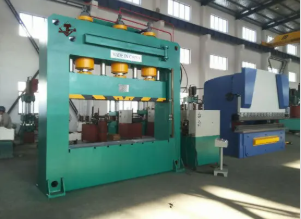Views: 0 Author: Site Editor Publish Time: 2025-10-20 Origin: Site









Hydraulic presses are powerful machines used in many industries. But how do you choose the right one for your business? Understanding the different types of hydraulic presses is key.
In this article, we will explore the top 15 hydraulic press types and their uses. You'll learn how to select the right press based on your needs.
C-frame hydraulic presses, often referred to as gap-frame presses, are widely appreciated for their compact design and accessibility. The 'C' shape allows for an open work area, making it easier to load and unload parts.
Compact design with an open-frame structure.
Excellent rigidity and fast pressing cycles.
Ideal for small to medium-sized tasks.
C-frame presses are used for various applications such as bending, punching, and straightening. They are particularly useful in automotive and appliance manufacturing, as well as sheet metal finishing.
Benefits:
Space-efficient design.
Fast setup and easy tool changes.
Limitations:
Not suitable for heavy-duty tasks due to limited force capacity
For light-duty tasks or operations where space is limited, a C-frame hydraulic press is an ideal solution.
H-frame hydraulic presses feature a robust frame that provides exceptional strength for heavy-duty applications. The 'H' shape ensures even distribution of pressure, making them ideal for tasks requiring high force.
Strong and stable framework for consistent pressure distribution.
Can handle larger and heavier workpieces.
These presses are commonly used in industries like aerospace, construction, and composite materials. They excel in deep drawing, forming, and compression molding tasks.
High durability for continuous use.
Precision and uniformity in results.
H-frame presses are a go-to choice for industries requiring high-volume, heavy-duty operations.

Four-post hydraulic presses are designed for applications that require high durability and precise pressure distribution. Their four vertical pillars offer superior stability and alignment for tooling setups.
Height-adjustable with four vertical support posts.
Offers precise die forming and minimal deflection.
These presses are ideal for rubber molding, diecasting, and plastic injection molding, where accuracy and versatility are crucial.
Excellent for large, irregularly shaped workpieces.
Superior alignment and tooling protection during operation.
Consider four-post hydraulic presses for applications that require maximum stability and alignment, such as die casting and high-precision molding.
Benchtop hydraulic presses are compact, space-saving machines designed for light to medium-duty tasks. They are perfect for small workshops or laboratory environments where limited space is available.
Small, easy-to-use, and cost-effective.
Ideal for light-duty applications like riveting and embossing.
Benchtop presses are commonly used for prototyping, research, and small-scale production in industries like electronics and education.
Pros:
Affordable and portable.
Great for educational or hobbyist use.
Cons:
Limited force capacity for heavy-duty operations.
Benchtop presses are excellent for light, non-industrial tasks where portability and affordability are essential.
When selecting a hydraulic press, understanding the difference between high-tonnage and low-tonnage presses is crucial. The force exerted by the press can greatly affect the efficiency of your production.
High-tonnage presses are ideal for heavy-duty applications that require immense force, such as forging, deep drawing, and large-scale metal forming.
Low-tonnage presses are used for lighter operations such as small part forming, punching, and embossing. They are typically found in research labs or small production environments.
To select the appropriate press, consider the material being processed, the desired output, and the force required. High-tonnage presses are suited for tough materials, while low-tonnage presses are more appropriate for delicate tasks. Choose a low-tonnage hydraulic press for smaller, precision work and a high-tonnage press for heavy-duty operations like forging and stamping.
There are several types of specialized hydraulic presses designed to tackle specific manufacturing challenges. These presses offer targeted solutions for industries that require unique capabilities.
The hydraulic wheel press is designed for mounting and unmounting wheels, bearings, and gears. It is commonly used in the automotive industry. Straightening Hydraulic Press is used to straighten shafts, tubes, and other elongated components, these presses ensure the precision alignment of critical parts.
Hydraulic mini presses are small, portable machines used in laboratories and research centers for light pressing tasks. Specialized hydraulic presses, such as the hydraulic wheel press or straightening press, provide tailored solutions for specific industries.
Choosing the right hydraulic press involves evaluating several factors to ensure the machine suits your production requirements. Here are some key considerations:
Tonnage: The amount of pressure the machine can apply.
Workspace dimensions: The available space in your facility.
Safety features: Essential to protect workers and ensure safe operation.
Different industries have different pressing needs. For instance, the automotive industry requires high-tonnage presses for large-scale metal forming, while the electronics industry may use smaller, more precise presses for components.
It's essential to choose a hydraulic press that requires minimal maintenance and is built to last. Consider after-sales support, component quality, and ease of repair.
When selecting a hydraulic press, prioritize safety features and long-term maintenance to ensure operational efficiency and worker safety.
Hydraulic presses are essential for various industrial processes, offering precision, power, and efficiency. Understanding the different types of hydraulic presses helps businesses choose the best machine for their needs. Whether it's a compact benchtop press for small tasks or a heavy-duty H-frame press for large-scale operations, selecting the right hydraulic press can boost production efficiency and product quality.
Choosing the right hydraulic press can optimize your production, reduce downtime, and enhance product quality. TSD offers high-quality hydraulic presses designed for efficiency and durability, providing value to industries with its reliable and versatile solutions.
A: A hydraulic press is a machine that uses hydraulic force to shape, form, or mold materials. It operates by applying pressure on a fluid to generate force for various tasks.
A: Hydraulic presses come in several types, including C-frame, H-frame, four-post, and benchtop presses. Each type is designed for specific applications, such as metal forming, punching, and assembly.
A: Consider factors like tonnage, workspace size, and application requirements. For heavy-duty tasks, an H-frame press is ideal, while a benchtop press suits light applications.